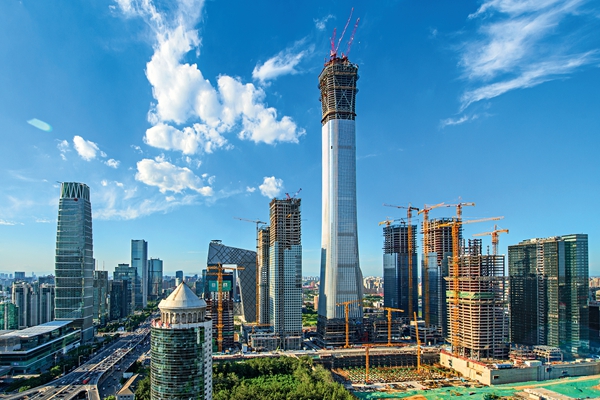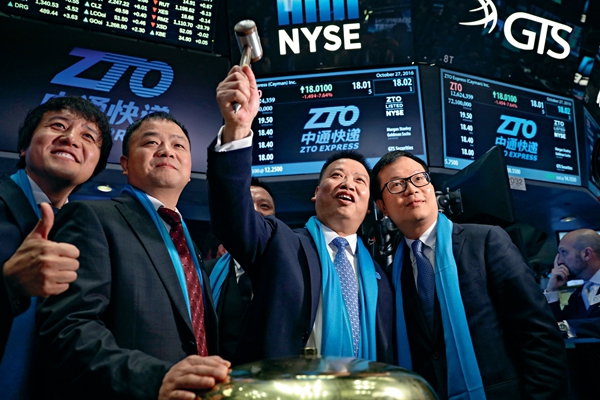China’s Contribution to Global Economic Growth
By LIU BAOKUI
THE International Monetary Fund predicts that the world economy will grow by 3.6 percent this year and China’s economy will swell by 6.7 percent, contributing around 35 percent to global growth. This year, China’s economy has progressed steadily with new highlights emerging. This, coupled with China’s proactive role in improving global governance, is propelling the world toward economic recovery.

Better Than Expected
China’s economy has maintained a progressive momentum in stable development with the growth rate staying at an average 6.9 percent in the first three quarters of the year. Its performance on key indicators like employment, commodity prices, and international balance of payments is better than expected. Newly added urban jobs during the period totaled 10.97 million, increasing by 300,000 over the same period of last year, which makes it possible to meet the national target of creating 11 million urban jobs in advance. The consumer price index rose 1.5 percent year on year, with 1.6 percent for urban areas and 1.1 percent for rural areas. Disposable income in China grows faster than GDP. Deducting inflation, the national per capita disposable income increased by 7.5 percent, 1.2 percentage points higher over the same period last year. The trade volume rose to RMB 20.293 trillion, up by 16.6 percent year on year, with exports taking up RMB 11.163 trillion and imports accounting for RMB 9.1299 trillion at a growth rate of 12.4 percent and 22.3 percent respectively. As other indexes on material volumes and related leading indicators also projecting an upbeat trend with the matching degree among indicators obviously enhanced, institutions at home and abroad have raised their growth forecast about China’s economy. The International Monetary Fund lifted its predictions of China’s economic growth of 2017-2018 by 0.1 percent in its latest report of World Economic Outlook. Meanwhile, the World Bank in its latest East Asia and Pacific Economic Update also changed its prediction of China’s economic growth to 6.7 percent from 6.5 percent.
New Highlights
In 2017, China’s economic performance has shown evident improvement in terms of quality, effectiveness, and structure owing to a range of new measures around the supply-side structural reform. Some new highlights have stood out in its steady development. The service sector’s contribution to China’s economic growth has further improved with the added value growth rate of the tertiary industry seeing a year-on-year increase of 8.3 percent in the first three quarters, 0.2 percentage points higher over the same period last year. Such producer services as transportation, warehousing, postal service, information transformation, software and information technology, leasing, and business service have grown rapidly. Meanwhile, consumption has become a major driving force for China’s economic growth. The first three quarters have witnessed the proportion of the service sector’s added value to the country’s GDP amount to 52.9 percent, with the final consumption expenditure’s contribution to GDP reaching 64.5 percent, a year-on-year increase of 2.8 percent. The national online retail sales volume totaled RMB 4.8787 trillion in the first three quarters, an annual increase of 34.2 percent, or 8.1 percentage points higher than the same period last year. Non-physical goods such as fitness and video app products have become new highlights of online retail sales as their volume surged to RMB 1.1969 trillion, increasing by 52.8 percent over the same period of last year.

China’s real economy is progressing towards the medium-high end. Hi-tech and equipment manufacturing has picked up its development pace with their growth rates standing at 13.4 percent and 11.6 percent respectively in the first three quarters, 6.7 and 4.9 percentage points higher than that of industries above designated size respectively. The added value of hi-tech manufacturing accounted for more than 12 percent of the total industries above designated size, and equipment manufacturing took up more than 32 percent of the total. China has also made headway in cutting overcapacity, with raw coal and crude steel output dropping by 9.7 percent and 1.1 percent respectively. As the sales-output ratio of industrial enterprises above a designated size reached 97.8 percent, excessive commodity inventory has been eased. As the system of separate business license, organization code certificate, and taxation registration certificate was replaced by a unified business license with a unified social credit code, enterprises’ organizational and bureaucratic burden has been alleviated. Surviving the dual pressure from some countries’ advantage in low cost and some developed countries’ re-industrialization, China’s competitive edge in manufacturing has been further sharpened. China has made major breakthroughs in key fields including aerospace, large aircraft, high-speed railway, numerically-controlled machine tool, and new energy vehicles, with examples like Blue Whale I drilling platform able to collect samples of combustible ice and China’s first target spacecraft Tiangong-1. China has also quickly risen in global competition in such fields as communication equipment, high-speed railway equipment, nuclear power equipment, and engineering machinery.
The shift in driving forces for development is accelerating. The Chinese government has introduced a slew of measures to liquidate some companies with overcapacity, and quicken upgrading of traditional industries. As mass entrepreneurship and innovation came into the limelight, new market entities have been nurtured. The first three quarters of the year saw the number of China’s newly-registered companies reach 4.51 million, a year-on-year increase of 12.5 percent, with daily newly-registered companies averaging 16,500, higher than the figure of last year. Newly registered enterprises in the manufacturing sector swelled by 21.7 percent year on year. Internet Plus is forming a new driving force for development. China’s economic performance in industrial robots, bike sharing, short-term renting, and online live streaming has become this year’s highlights. Mobike’s business has ventured into the U.K., Singapore, and Japan. China’s innovation capacity has been remarkably improved. In the first three quarters, patent applications totaled 2.48 million. In the Global Innovation Index 2017 released by the World Intellectual Property Organization, China was positioned at 22nd, rising from 34th in 2012.
The country’s efforts in taming the real estate market have shown effect. In 2017, the central government has intensified its control of the real estate market by introducing targeted measures for different cities in light of the principle “housing is for living in, not for speculation.” The speculation demands have been curbed in first-tier cities and market expectation has become stable as the annual increase rate of newly-built commodity housing prices in the four metropolises of Beijing, Shanghai, Guangzhou, and Shenzhen has fallen for 11 consecutive months. Meanwhile, destocking efforts in third and fourth-tier cites have made headway; by the end of September, unsold housing floor space nationwide has dropped by 12.2 percent year on year. The long-term mechanism and fundamental system building of the real estate market has quickened with a range of policies introduced to boost and improve the housing leasing market.
A Propeller to Global Economic Recovery
The stable growth of China’s economy has made the country a major propeller of global economic recovery. China’s contribution to world economic growth has increased continuously, and is projected to reach around 35 percent in 2017 according to the IMF.

China is also boosting recovery of world trade. Since the European debt crisis, the global trade protectionism and anti-globalization trend has gained ground. China’s remarkable increase in imports and exports is reversing the trend. China’s trade volume in the first three quarters of the year increased by 16.6 percent year on year. The World Trade Organization statistics show that China’s imports accounted for 10.9 percent of the world’s total during the period of January-August, 0.7 percentage points higher than the same period of 2016, a great booster to the world trade recovery. New forms of trade businesses have developed by leaps and bounds with cross-border e-commerce retail sales and market purchase trade soaring by 66.7 percent and 27.8 percent. The first three quarters have seen China’s imports climb by 22.3 percent, a great spur to global demand. Apart from traditional made-in-China labor-intensive products, China has exported hi-tech products like bullet trains, nuclear power equipment, and complete sets of equipment. In the first three quarters, the growth of mechanical and electrical product exports outran that of labor-intensive product exports.

The Belt and Road Initiative is gathering momentum. In the first three quarters, China’s newly instilled investment to 57 countries along the Belt and Road amounted to US $9.6 billion, accounting for 12.3 percent of China’s overall outbound investment during the period, up 4 percentage points year on year. China’s trade with countries along the routes has also risen remarkably. China’s trade volume with Russia, Poland, and Kazakhstan expanded by 27.7 percent, 24.8 percent, and 41.1 percent respectively. China’s investment and cooperation projects in countries along the routes have spurred local economic growth and employment. As of the end of August, Chinese enterprises created 247,000 jobs for those countries. Sihanoukville Special Economic Zone of Cambodia has developed into a major production base for textile products, with its contribution to Sihanoukville Province’s economic growth exceeding 50 percent, creating 17,000 local jobs. China-Europe freight trains connect China’s cities with 34 cities in 12 European countries via 57 lines traversing the New Eurasian Continental Bridge and Siberian Landbridge. With 2,500 trains shuttling to and fro since 2017, products exported from China have expanded to textile products, cars and parts, machinery equipment and furniture from small items and electronic products at the beginning, meanwhile, French wine, German beer, and Polish milk have been imported by China.
China offers a Chinese approach to problems facing humankind, and is playing an even greater role in global governance by putting forward such concepts as a community with a shared future for humankind, promoting democratization of the global governance system, and endeavors to give more say to developing countries. The 2017 Xiamen BRICS Summit ushered in the second golden decade for the BRICS cooperation mechanism. Determined to build a more effective global economic governance framework commensurate to the world new economic landscape, the member state leaders issued the Xiamen Declaration, with a variety of agreements, declarations, and consensus documents on political and security cooperation, economic cooperation, and people-to-people exchanges reached. All these will help give emerging market countries more say in global governance, ease the world’s imbalanced development, and instill new impetus to global economic growth.
LIU BAOKUI is an associate research fellow with the Chinese Academy of Macroeconomic Research.
